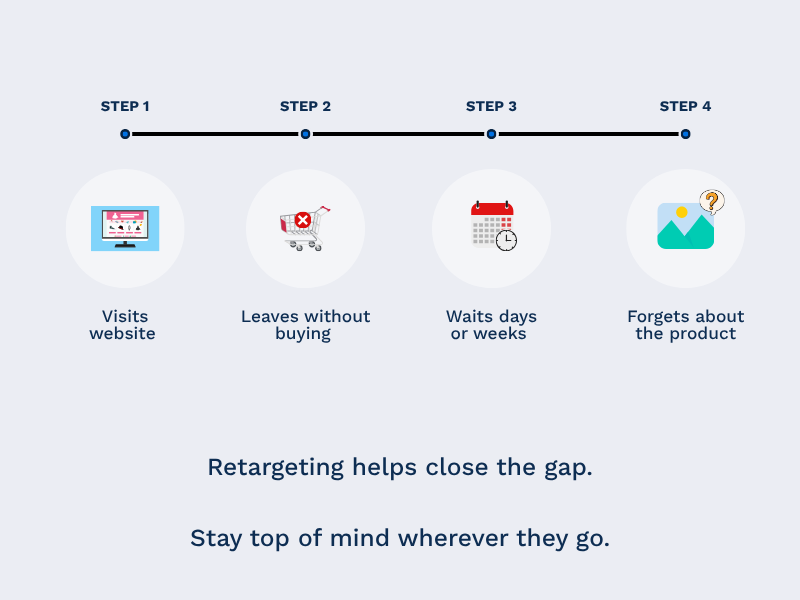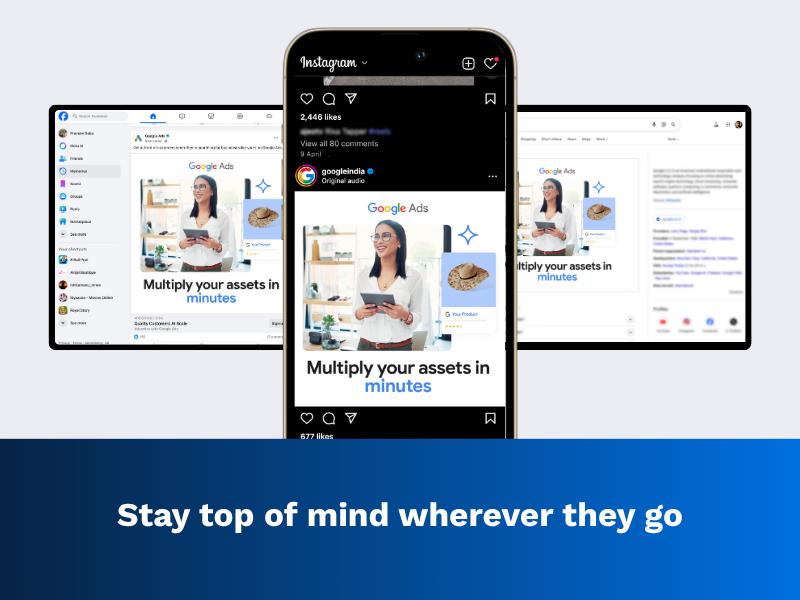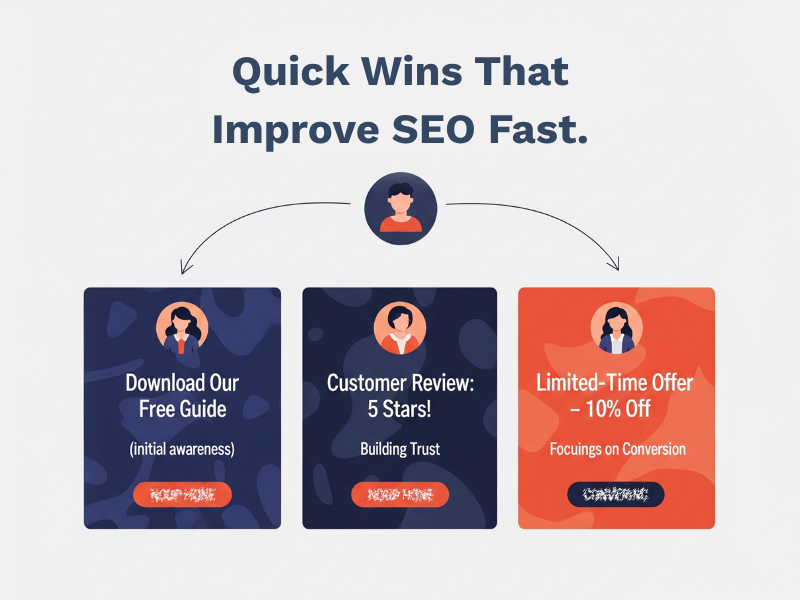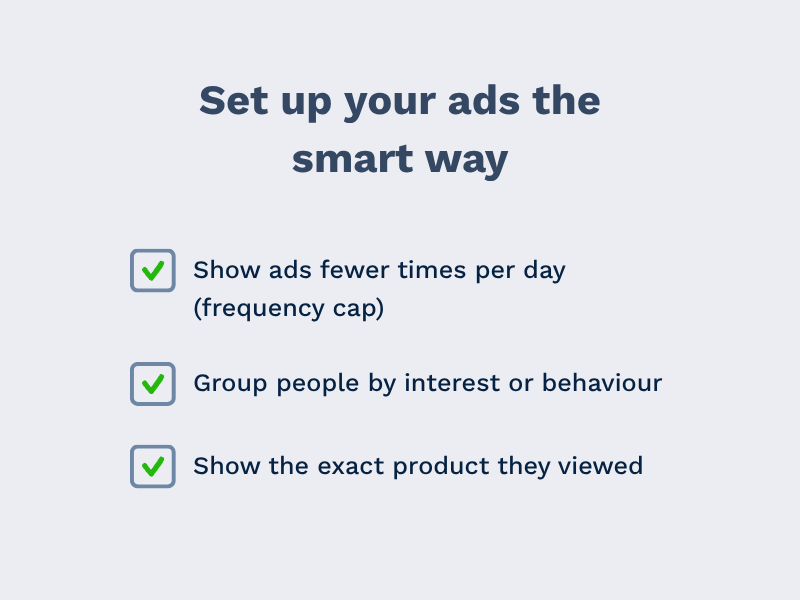Imagine this: a potential customer lands on your website, clicks through a few pages, maybe even adds a product to their cart and then disappears. Days go by, weeks even, with no action. If this sounds familiar, you’re not alone. Many businesses, especially in high-consideration industries, struggle with long sales cycles where leads need multiple nudges before making a decision.
The problem is that every day that passes without a follow-up is an opportunity for a competitor to swoop in or for your lead to simply lose interest.
That’s where retargeting ads come in. Studies show that retargeted customers are 70% more likely to complete a purchase and that returning visitors-often reached through retargeting-account for nearly half of all ecommerce transactions.
By using multi-touchpoint retargeting and sequential messaging, businesses can boost ad engagement by up to 400% and achieve conversion rates nearly three times higher than standard ads. In industries with long sales cycles, these strategies keep your brand top-of-mind and help move leads from consideration to conversion faster.

For many businesses, especially in sectors like B2B, real estate, finance or high-ticket eCommerce, the path to purchase isn’t straightforward. A visitor might browse your site, download a guide or attend a webinar, but still not be ready to commit. This drawn-out buyer’s journey is normal, but it comes with real challenges.
One major issue is the risk of losing attention. In the time it takes a potential customer to evaluate their options, competitors are ramping up their marketing efforts. If you’re not actively re-engaging your leads, someone else will be. A prospect who once showed interest in your product can easily be swayed by a brand that simply stayed more visible during their decision-making window.
Another challenge is lead fatigue. Without regular, relevant touchpoints, interest can fizzle out. People forget the value your product offers, or worse, forget your brand entirely. It's not because your offer isn’t strong; it’s because you're no longer part of their consideration set.
And then there’s the reality of distraction. Life gets busy. Even interested buyers may abandon their journey due to everyday interruptions, leaving their cart full or your proposal unread. If you’re not following up with purposeful messaging, those leads won’t necessarily come back on their own.
This is where retargeting becomes essential. By keeping your brand in front of potential customers and gently guiding them back to where they left off, you can dramatically improve your chances of closing the sale, without relying on them to remember you on their own.

One of the biggest misconceptions about retargeting ads is that a single ad will bring users back. In reality, it takes multiple interactions to move someone from awareness to action. That’s where multi-touchpoint retargeting comes in.
This approach involves serving different types of ads at various stages of the buyer’s journey, making sure your messaging evolves as the user gets closer to converting. Instead of repeating the same generic ad, you tailor your content based on what the user has already done and what they need to see next.
Some of the best retargeting audiences include website visitors who browsed key pages but didn’t convert, users who started filling out a form or shopping cart but abandoned the process and even previous customers who haven’t re-engaged in a while. Each of these audiences is at a different stage and requires a different message.
To make your strategy even more effective, adopt cross-platform retargeting. Your potential customer might visit your site on their laptop, check Instagram on their phone, then scroll through LinkedIn the next morning. By serving retargeting ads across multiple platforms like Google, Facebook, Instagram and LinkedIn, you maximise visibility and maintain presence throughout their journey, no matter where they are online.
The goal of multi-touchpoint retargeting is not just to remind users you exist, but to progressively build trust, offer value and nudge them closer to taking the next step.

Not all leads are ready to convert the first time they hear about your business. Many may interact with your brand multiple times before making a decision. That’s why nurturing cold leads is just as important as attracting new ones, and retargeting ads are one of the most effective ways to do it.
The key lies in personalising your messaging based on where someone is in their journey. For example, if a visitor is landing on your site for the first time, it’s better to serve educational content that builds awareness. Think blog posts, explainer videos or downloadable guides that position your brand as helpful and knowledgeable.
For returning visitors who have shown more interest, such as those who viewed specific product or service pages, you can shift towards trust-building content. Ads that include case studies, customer testimonials or short demo videos work well here. If they’ve added something to their cart or started a form, it’s time to introduce urgency. Limited-time discounts or reminders about low stock levels can reignite intent.
To make this nurturing process more engaging, use video and carousel ads. These formats allow you to showcase product features, highlight customer success stories or walk users through a problem-solution journey in a visually compelling way.
Finally, don’t forget to test and optimise. Run A/B tests on your retargeting ads to see which headlines, images or CTAs drive the most conversions. What works for one segment may fall flat for another, so use performance data to continually refine your approach.
By combining personalisation, smart creative choices and consistent testing, you can warm up even the coldest leads and guide them back into your sales funnel.

Retargeting works best when it’s carefully refined rather than overly aggressive. While it’s tempting to show your ads to every site visitor, overexposure can lead to fatigue and reduced effectiveness. To shorten your sales cycle without frustrating your audience, it's essential to optimise your retargeting ads with strategy and subtlety.
One of the most important starting points is to set frequency caps. Showing the same ad too often can make your brand feel pushy or repetitive. By limiting how frequently your ads appear to the same user, you keep your messaging fresh and avoid ad fatigue. This small adjustment helps maintain a positive perception of your brand while staying visible in a respectful way.
Next, look at how you're segmenting your audience. Not all visitors should be treated equally. A user who visited your pricing page or added a product to their cart is much closer to converting than someone who briefly skimmed a blog post. By segmenting your audience based on engagement level, you can serve high-intent users stronger calls to action while continuing to nurture those who are still in the awareness phase.
For e-commerce businesses, dynamic retargeting is a must. Rather than displaying a generic message, dynamic ads automatically show users the exact products they viewed, along with pricing, availability or promotional offers. This level of personalisation significantly improves click-through and conversion rates, especially when paired with urgency-driven messaging.
The key to faster sales isn’t chasing leads harder; it’s retargeting them smarter. With the right frequency, audience segmentation and personalised content, your ads can become a helpful reminder rather than a distraction.
At Mr Digital, we worked with a multi-category e-commerce client looking to reduce cart abandonment and improve conversion rates. Through smart segmentation and dynamic ad retargeting, we re-engaged users who had previously dropped off, tailoring ads based on viewed products and browsing behaviour.
We also tested variations of “Sale” icon designs and optimised product listings to increase relevance and click-through rates. These small but strategic changes helped the client achieve a 157% increase in new users while lowering acquisition costs and shortening the average time to conversion.
It’s a clear reminder that successful retargeting isn’t about following users endlessly; it’s about giving them the right reason to come back.
Long sales cycles are a reality for many businesses, but with the right tools and tactics, you don’t have to sit back and wait. Retargeting ads give you a proactive way to stay in front of your leads, keep your brand top of mind and guide users toward conversion at their own pace.
By focusing on multi-touchpoint retargeting, nurturing cold leads with tailored offers and optimising your campaign setup, you can accelerate the decision-making process without overwhelming your audience. The result is a smarter, more strategic marketing approach that not only boosts conversions but also builds stronger customer relationships over time.
Want to convert leads faster? Let’s build a data-driven retargeting strategy that accelerates sales.